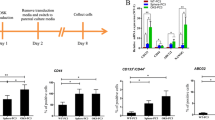Summary
Recent studies suggested that the prostate cancer may arise from prostate cancer stem cells that share some same characteristics with normal stem cells. The purpose of this study was to detect the differences of Nanog expression between PC3 prostate cancer cell line and its tumor stem cells, and the relationship was preliminarily examined between Nanog and prostate cancer and its tumor stem cells. By using magnetic active cell sorting (MACS), we isolated a population of CD44+/CD133+ prostate cancer cells that display stem cell characteristics from PC3 cell line. Immunohistochemistry revealed positive expressions of CD44, CD133 and α2β1-integin in the isolated cells. CCK-8 analysis showed that isolated cells had a strong proliferative ability. The formation of the cell spheres in serum-free medium and holoclones in serum-supplied medium showed that the cells were capable of self-renewing, indicating that the isolated cells were a population of cancer stem-like cells derived from PC3 cell line. Western blotting exhibited that the isolated cells had higher experession of Nanog, an embryonic stem marker, as compared with PC3 cells. Our study showed that Nanog might be helpful in sustaining the self-renewal and the undifferentiation of prostate cancer stem cells, and may serve as a marker for prostate cancer stem cells for isolation and identification.
Similar content being viewed by others
References
Gibbs CP, Kukekov V G, Reith J D, et al. Stem-like cells in bone sarcomas: implications for tumorigenesis. Neoplasia, 2005,7(11):967–976
Al-Hajj M, Wicha MS, Benito-Hernandez A, et al. Prospective identification of tumorigenic breast cancer cells. Proc Natl Acad Sci USA, 2003,100(7):3983–3988
Singh SK, Hawkins C, Clarke ID, et al. Identification of human brain tumour initiating cells. Nature, 2004,432(7015):396–401
Kim CF, Jackson EL, Woolfenden AE, et al. Identification of bronchioalveolar stem cells in normal lung and lung cancer. Cell, 2005,121(6):823–835
Hope KJ, Jin L, Dick JE. Acute myeloid leukemia originates from a hierarchy of leukemic stem cell classes that differ in self-renewal capacity. Nat Immunol, 2004,5(7): 738–743
Reya T, Morrison SJ, Clarke MF, et al. Stem cells, cancer, and cancer stem cells. Nature. 2001,414(6859): 105–111
Jordan CT. Cancer stem cell biology: from leukemia to solid tumors. Curr Opin Cell Biol, 2004,16(6):708–712
Collins AT, Berry PA, Hyde C, et al. Prospective identification of tumorigenic prostate cancer stem cells. Cancer Res, 2005,65(23):10946–10951
Pfeiffer MJ, Schalken JA. Stem cell characteristics in prostate cancer cell lines. Eur Urol, 2010,57(2):246–254
Patrawala L, Calhoun T, Schneider-Broussard R, et al. Highly purified CD44+ prostate cancer cells from xenograft human tumors are enriched in tumorigenic and metastatic progenitor cells. Oncogene, 2006,25(12): 1696–1708
Mitsui K, Tokuzawa Y, Itoh H, et al. The homeoprotein Nanog is required for maintenance of pluripotency in mouse epiblast and ES cells. Cell, 2003,113(5):631–642
Chambers I, Colby D, Robertson M, et al. Functional expression cloning of Nanog, a pluripotency sustaining factor in embryonic stem cells. Cell, 2003,113(5): 643–655
Lin T, Chao C, Saito S, et al. p53 induces differentiation of mouse embryonic stem cells by suppressing Nanog expression. Nat Cell Biol, 2005,7(2):165–171
Hart AH, Hartley L, Parker K, et al. The pluripotency homeobox gene NANOG is expressed in human germ cell tumors. Cancer, 2005,104(10):2092–2098
Hoei-Hansen CE, Sehested A, Juhler M, et al. New evidence for the origin of intracranial germ cell tumours from primordial germ cells: expression of pluripotency and cell differentiation markers. J Pathol, 2006,209(1):25–33
Ben-Porath I, Thomson MW, Carey VJ, et al. An embryonic stem cell-like gene expression signature in poorly differentiated aggressive human tumors. Nat Genet, 2008, 40(5):499–507.
Gibbs CP, Kukekov VG, Reith JD, et al. Stem-like cells in bone sarcomas: implications for tumorigenesis. Neoplasia, 2005,7(11):967–976
Li H, Chen X, Calhoun-Davis T, et al. PC3 human prostate carcinoma cell holoclones contain self-renewing tumor-initiating cells. Cancer Res, 2008,68(6):1820–1825.
Patrawala L, Calhoun-Davis T, Schneider-Broussard R, et al. Hierarchical organization of prostate cancer cells in xenograft tumors: the CD44+alpha2beta1+ cell population is enriched in tumor-initiating cells. Cancer Res, 2007,67(14):6796–6805
Hurt EM, Kawasaki BT, Klarmann GJ, et al. CD44+ CD24(−) prostate cells are early cancer progenitor/stem cells that provide a model for patients with poor prognosis. Br J Cancer, 2008,98(4):756–765
Dontu G, Abdallah WM, Foley JM, et al. In vitro propagation and transcriptional profiling of human mammary stem/progenitor cells. Genes Dev, 2003,17(10):1253–1270
Lee J, Kotliarova S, Kotliarov Y, et al. Tumor stem cells derived from glioblastomas cultured in bFGF and EGF more closely mirror the phenotype and genotype of primary tumors than do serum-cultured cell lines. Cancer Cell, 2006,9(5):391–403
Li H, Jiang M, Honorio S, et al. Methodologies in assaying prostate cancer stem cells. Methods Mol Biol, 2009, 568:85–138
Vander GD, Karthaus WL, Dalrymple S, et al. The role of CD133 in normal human prostate stem cells and malignant cancer-initiating cells. Cancer Res, 2008,68(23): 9703–9711
Richardson GD, Robson CN, Lang SH, et al. CD133, a novel marker for human prostatic epithelial stem cells. J Cell Sci, 2004,117(Pt 16):3539–3545
Wang SH, Tsai MS, Chiang MF, et al. A novel NK-type homeobox gene, ENK (early embryo specific NK), preferentially expressed in embryonic stem cells. Gene Expr Patterns, 2003,3(1):99–103
Booth HA, Holland PW. Eleven daughters of NANOG. Genomics, 2004,84(2):229–238
Zhou S, Li F, Xiao J, et al. Isolation and identification of cancer stem cells from human osteosarcom by serum-free three-dimensional culture combined with anticancer drugs. J Huazhong Univ Sci Technolog [Med Sci], 2010,30(1): 81–84
Author information
Authors and Affiliations
Corresponding author
Additional information
This project was supported by a grant from the Ministry of Education of People’s Republic of China (No. 200804871-051).
Rights and permissions
About this article
Cite this article
Gong, C., Liao, H., Guo, F. et al. Implication of expression of Nanog in prostate cancer cells and their stem cells. J. Huazhong Univ. Sci. Technol. [Med. Sci.] 32, 242–246 (2012). https://doi.org/10.1007/s11596-012-0043-5
Received:
Published:
Issue Date:
DOI: https://doi.org/10.1007/s11596-012-0043-5




